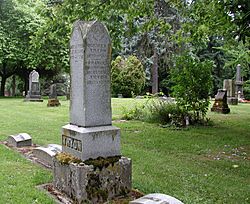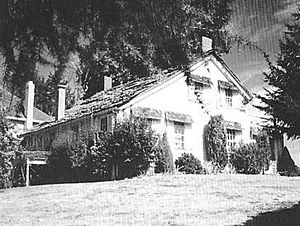Socrates Hotchkiss Tryon Sr. facts for kids
Socrates Hotchkiss Tryon Sr. (born January 24, 1816 – died May 15, 1855) was an early doctor and pioneer in what became the U.S. state of Oregon. He was born in Vermont. Later, he lived in Iowa and California.
He then moved to the Oregon Territory. There, he settled on land that is now part of the Tryon Creek State Natural Area in Portland and Lake Oswego. He also helped create the rules for Iowa to become a state.
Early Life and Moving West
Socrates Tryon was born on January 24, 1816. His hometown was Pawlet Township, Vermont. His parents were Laura Hotchkiss and Jesse Tryon. His grandfather, Socrates Hotchkiss, was also a doctor.
Socrates Tryon studied at Castleton Medical College. He finished his studies in the spring of 1836. After college, he moved to the Iowa Territory. He lived in Linn County. In 1840, he worked as a clerk for the United States District Court. The governor offered him the job of sheriff in 1839, but Tryon did not take it.
In May 1846, Tryon represented Linn and Benton counties. This was at Iowa's Second Constitutional Convention. This meeting helped Iowa become a state in December of that year. After this, Tryon moved to California. He went with his wife, Frances (her maiden name was Safley), and their son, Socrates Hotchkiss Tryon Jr.
From California, they moved north to the Oregon Territory. He was one of the first doctors in Oregon. In 1850, he claimed land near what is now Lake Oswego. This was done through a special law called the Donation Land Claim Act.
Life in Oregon
The Tryon family grew when their second child, Sallie, was born in 1852. Socrates Tryon farmed his land. This land was near what is now Stampher Road in Lake Oswego. He also built a sawmill there. He built a house on his property too.
His house was one of the few built in Clackamas County. This was during the time Oregon was a territory (1848–1859). The house was described in a book about classic Portland homes. It was torn down in the 1990s. Before it was removed, it was the only house in the Portland area still on its original land claim.
The house was a simple farmhouse. It had a brick and stone foundation. It also had some simple Greek Revival style details. It stood on a hill overlooking the Willamette River. Socrates Tryon died in Oregon on May 15, 1855. He was buried in Lone Fir Cemetery in southeast Portland.
He left his land to his wife, Frances. In 1869, she gave the land to their children. These were Socrates Tryon Jr. and Sallie, along with Sallie's husband, A.A. Cleveland. In 1874, they sold the 645 acres (261 ha) property. The buyer was the Oregon Iron Company. Frances and Socrates Tryon Jr. were also buried at Lone Fir Cemetery.
Tryon's Lasting Legacy
For almost 25 years, the Oregon Iron Company used the old Tryon land. They cut down trees like cedar and fir. These trees were used in their metal factory in Lake Oswego. More logging happened from 1912 until 1961.
In 1969, Multnomah County bought part of the old property. They wanted to use it as a park. More land was added later. A state park was created in 1970. This park is now called Tryon Creek State Natural Area.
Tryon Creek flows through this natural area. It also flows through the land Tryon used to own. The creek then joins the Willamette River near Lake Oswego. The creek was named after Socrates Tryon. The old logging road used by the Oregon Iron Company is now a trail. It is called Old Iron Mountain Trail in the state natural area.



